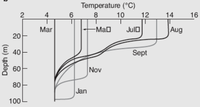
Photo from wikipedia
This study investigates the physical processes controlling the mixed layer buoyancy using a regional configuration of an ocean general circulation model. Processes are quantified by using a linearized equation of… Click to show full abstract
This study investigates the physical processes controlling the mixed layer buoyancy using a regional configuration of an ocean general circulation model. Processes are quantified by using a linearized equation of state, a mixed-layer heat, and a salt budget. Model results correctly reproduce the observed seasonal near-surface density tendencies. The results indicate that the heat flux is located poleward of 10° of latitude, which is at least three times greater than the freshwater flux that mainly controls mixed layer buoyancy. During boreal spring-summer of each hemisphere, the freshwater flux partly compensates the heat flux in terms of buoyancy loss while, during the fall-winter, they act together. Under the seasonal march of the Inter-tropical Convergence Zone and in coastal areas affected by the river, the contribution of ocean processes on the upper density becomes important. Along the north Brazilian coast and the Gulf of Guinea, horizontal and vertical processes involving salinity are the main contributors to an upper water change with a contribution of at least twice as much the temperature. At the equator and along the Senegal-Mauritanian coast, vertical processes are the major oceanic contributors. This is mainly due to the vertical gradient of temperature at the mixed layer base in the equator while the salinity one dominates along the Senegal-Mauritania coast.
Journal Title: Atmosphere
Year Published: 2020
Link to full text (if available)
Share on Social Media: Sign Up to like & get
recommendations!